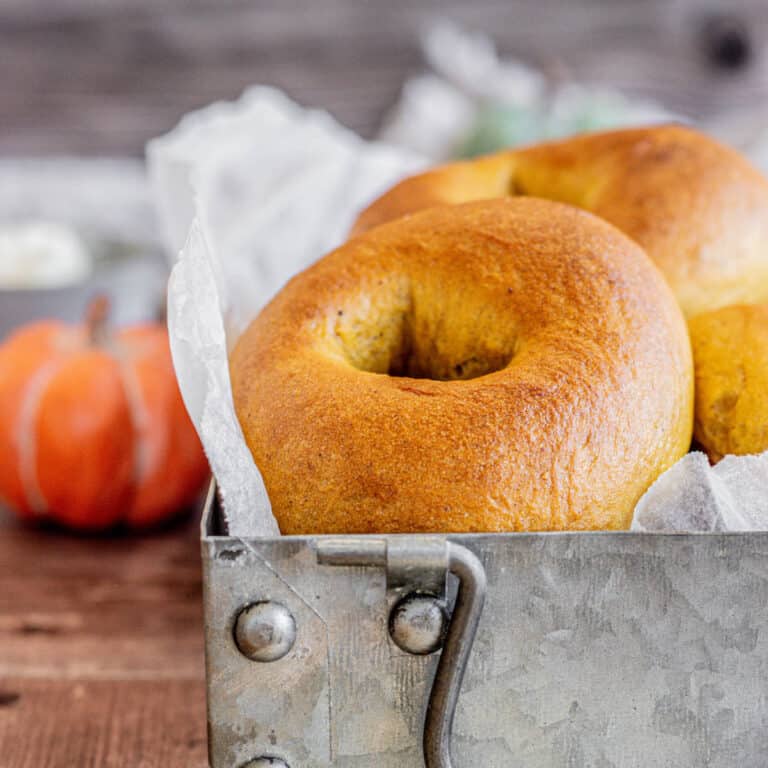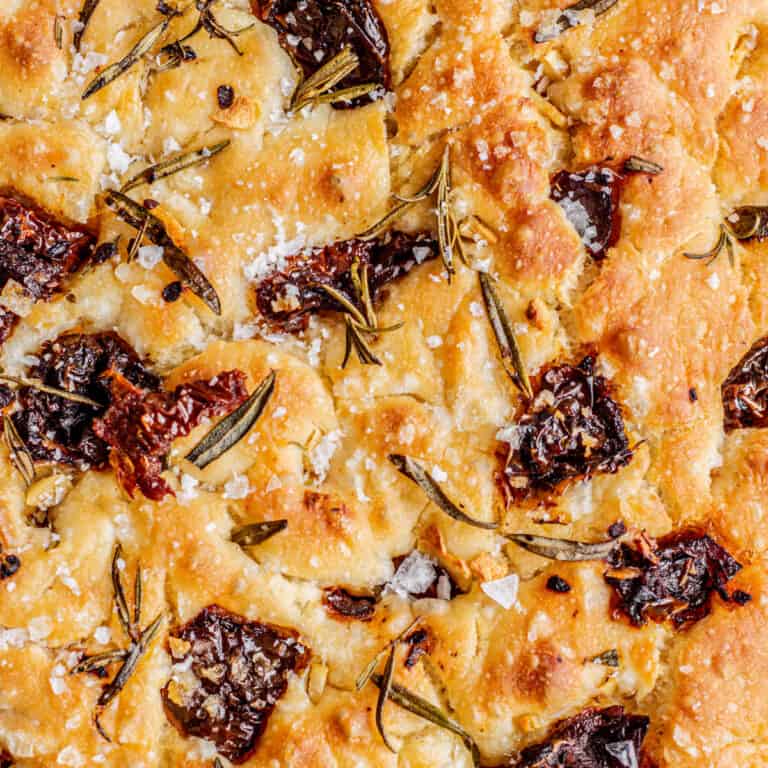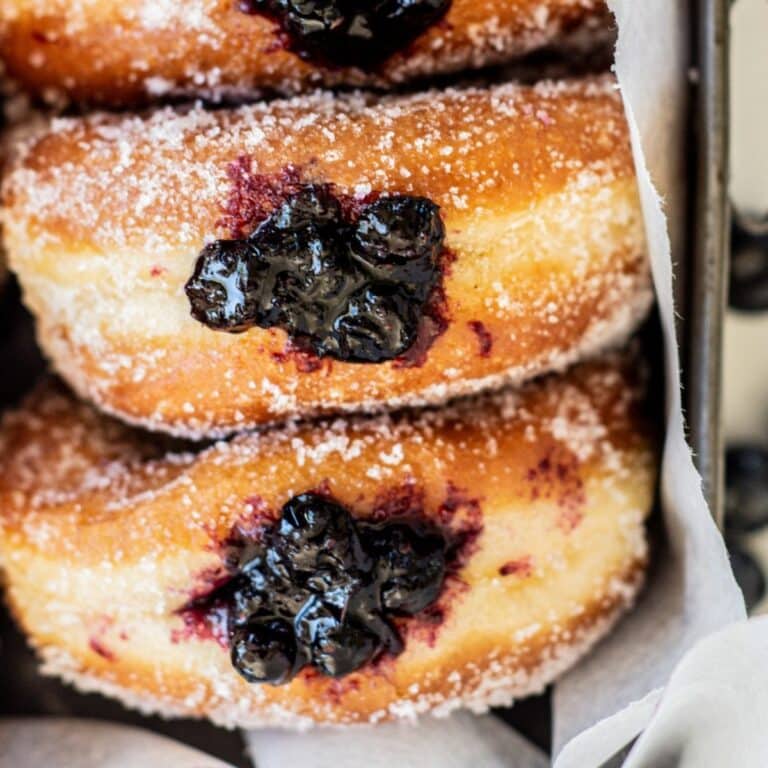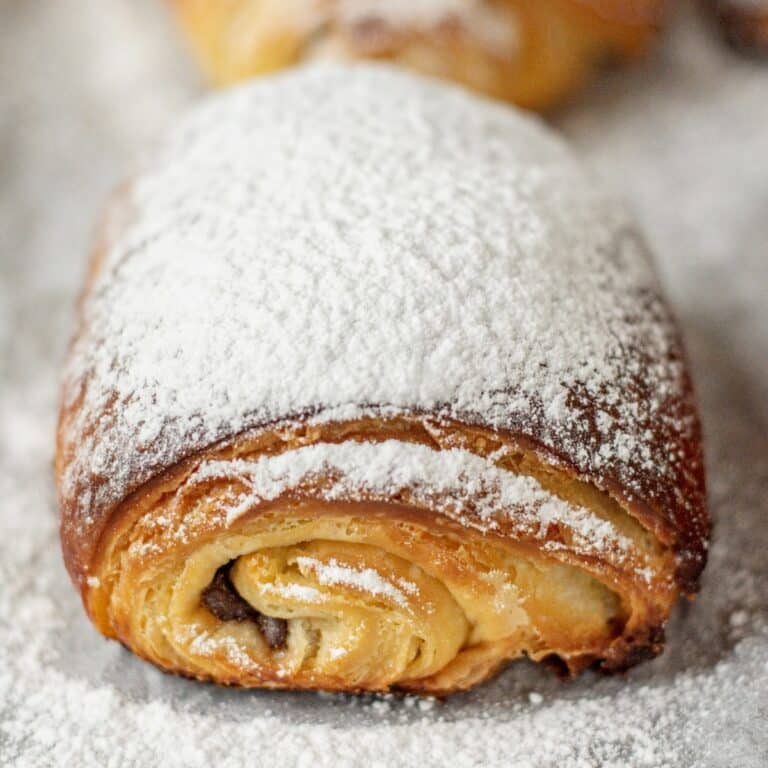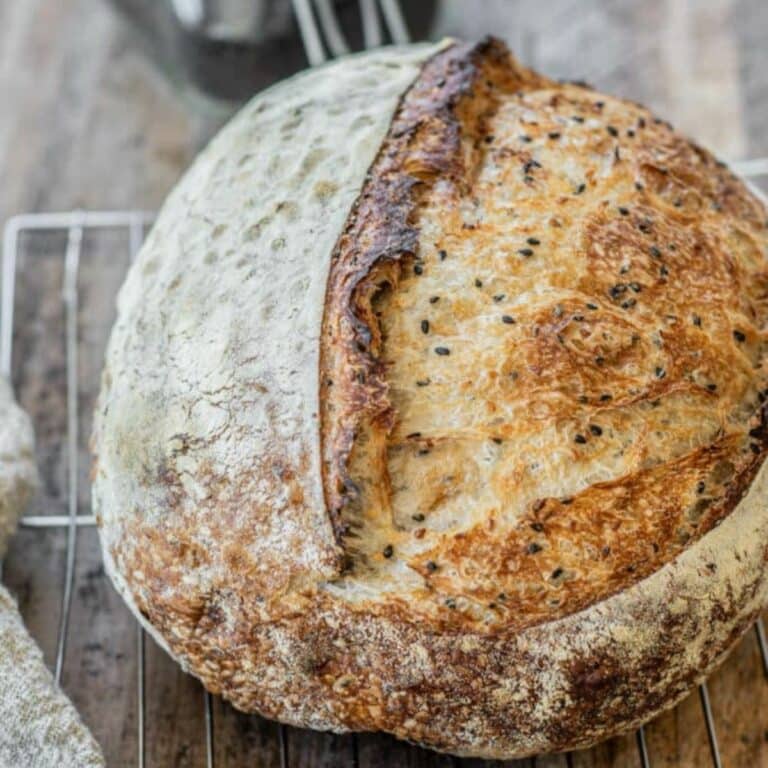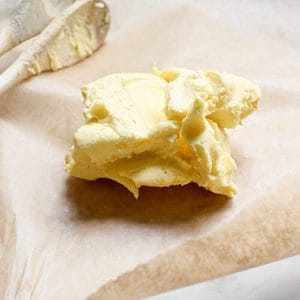The Best Sourdough Focaccia Recipe
This sourdough focaccia recipe has a light and soft interior and a deliciously crispy exterior.
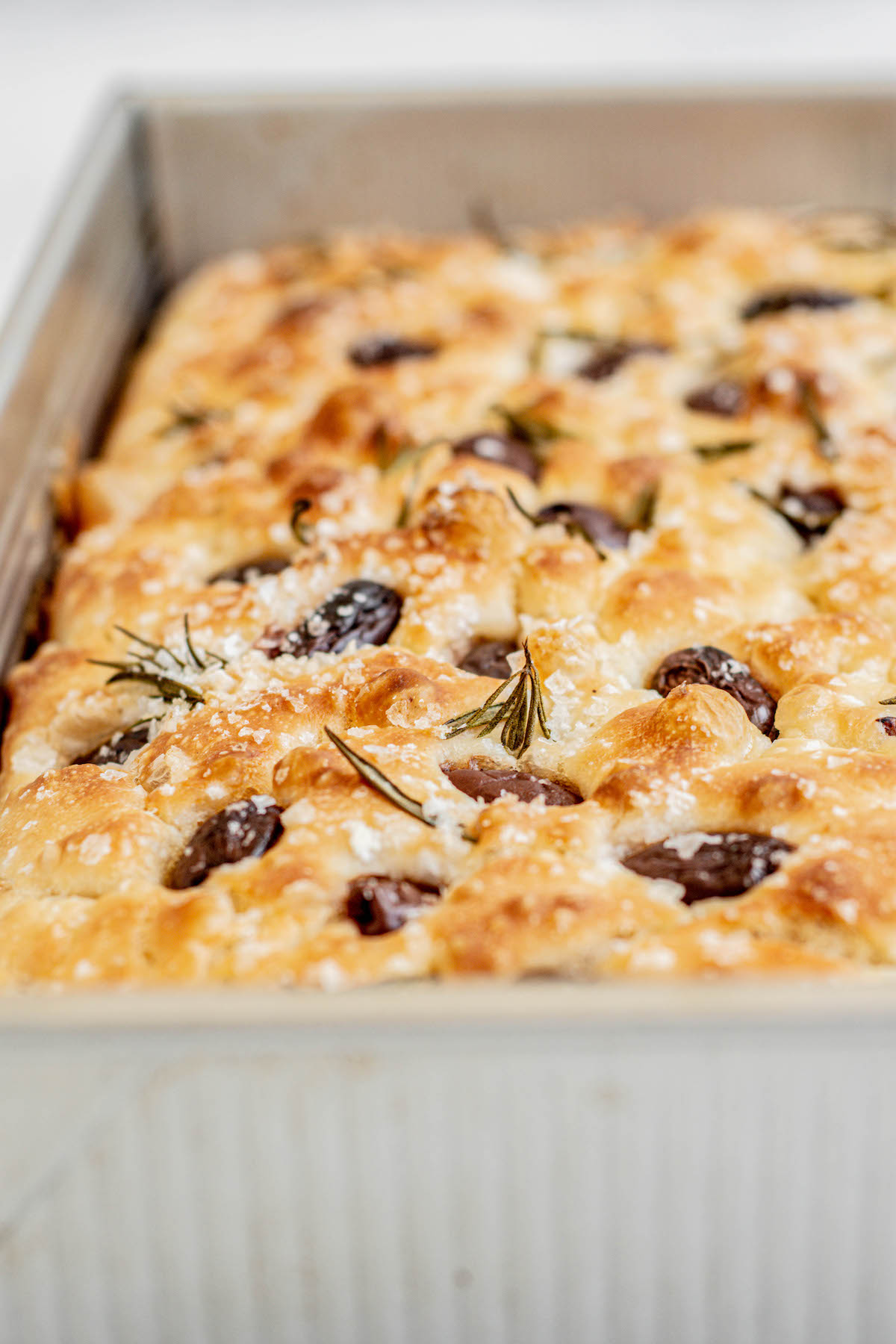
This combination of textures in this sourdough focaccia comes from an airy sourdough-leavened dough that’s coated in a generous amount of olive oil. While it bakes, this olive oil crisps up the outside of the dough. This gives the best crispy crust which contrasts so well with the airy interior and chewy crumb.
Like most of my sourdough recipes, I spread the process over two days to give the dough a cold rest in the fridge overnight. This brings much more flavor and texture to the bread.
Ingredients
Find the amounts of the ingredients in the printable recipe card at the bottom of this post. Here is a rundown of what you will need.
- All-purpose flour. A strong all-purpose flour can be used in this recipe. Check the protein level, a flour with a protein level of at least 11% is best. You can also use bread flour, or a mix of both bread and all-purpose flour.
- Water. This dough has very high hydration, and a lot of water is used. This focaccia bread has around 87% hydration. Work it out with this hydration calculator. It makes traditional kneading a bit hard, so a stretch and fold method will be used.
- Salt. The salt adds flavor and strength to the gluten. Flaky sea salt is also added later as a topping.
- Active sourdough starter – This is what will leaven the bread.
- Extra-virgin olive oil. The bread is lavishly coated in a few tablespoons of extra virgin olive oil before it is baked. This creates a fried crust on the outside and adds wonderful flavor.
- Fresh rosemary and olives – These are the toppings for this traditional rosemary and olive focaccia, though you could substitute them with many other ingredients. Sun-dried tomatoes, capers, cherry tomatoes, other fresh herbs, onions, garlic, or even thinly sliced potatoes work well.

Equipment
There isn’t a mixer needed for this recipe as it’s easily stretched and folded by hand.
You will need a baking pan or a cast-iron skillet to bake the focaccia bread in. This recipe is using 9x13inch USA metal baking pan.
Baker’s schedule
More details are in the recipe card below along with the final recipe and ingredients but here is an outline of the timings. They are flexible to fit around your schedule, so tweak if you need to to find what works.
Day 1. This is the feeding of the starter and the mixing and stretching of the dough in a large bowl. The dough then goes in the refrigerator for a long cold-proof overnight. This cold-proof part is important for flavour.
Day 2. The cold dough is pressed into a pan along with a few tablespoons of olive oil. It is then left to rise and become puffy. Afterwards, it’s topped with flaky salt, herbs, and olives, and baked.

The sourdough starter
You need an active starter for this sourdough focaccia bread.
I use a ratio of 1:2:2 to feed my sourdough starter in preparation for the dough. That means 1 part starter, 2 parts flour, and 2 parts water, all measured in weight.
For this bread, I measured out 25g starter, 50g flour, and 50g water. Use the starter when it has at least doubled but before it collapses for the best result.
Instructions
In the morning or the evening before, feed your sourdough starter. Let it rise until doubled in size.
In a large bowl, add water, sourdough starter, flour and salt. Use a rubber spatula or wooden spoon to combine it all together into a wet and shaggy dough.
Over a period of 2 hours, perform 4 sets of stretch and folds, one every 30 minutes.
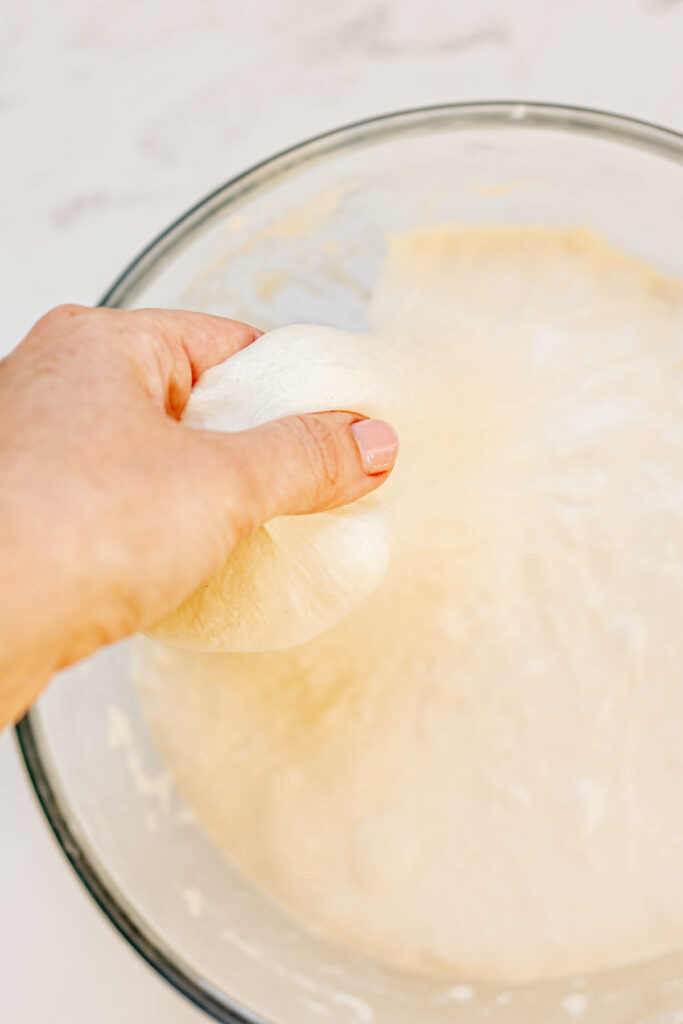
In each set, stretch and fold the dough over 4-5 times, turning the bowl each turn.
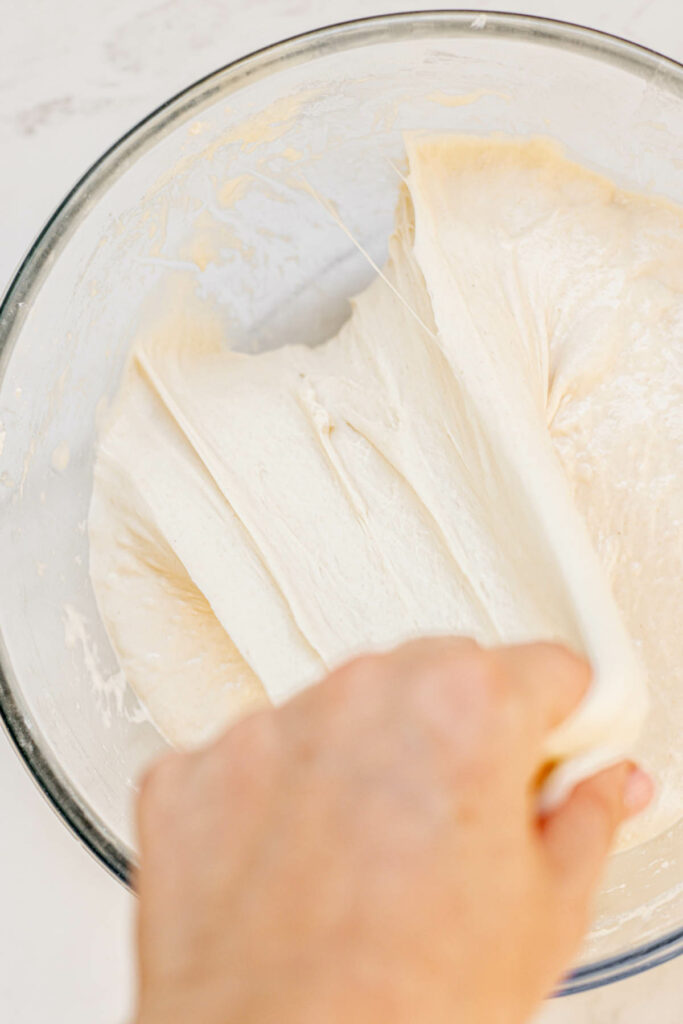
The first set of folds will be very messy and the dough will tear. As time passes, the dough will become more and more elastic.
Each time the dough sits, cover the bowl with a damp kitchen towel to stop the top of the dough from drying out.
Bulk fermenting
After the final stretch and fold the dough rise at room temperature around for 2-4 hours. There should be signs of bulk fermentation happening in the dough with many bubbles appearing.
This depends on the temperature of your kitchen. A cooler kitchen will the dough to sit a bit longer, or you can create a warm spot by placing a mug of boiled water in a turned-off oven.
Transfer the dough to an airtight container or cover the bowl with plastic wrap. Place it in the fridge overnight, or for up to 36 hours for an extra-long ferment. It can be in the fridge for a long time if that suits your schedule. The yeast fermentation process is slowed in cool temperatures, but the bacteria get to work and bring the flavour.
Shaping
Drizzle the bottom of the baking tray with a generous amount of olive oil. You can line the pan with parchment paper as well if you think your pan might stick. Transfer the cold dough to the oiled pan.
Leave it to sit and rest for 10 minutes, then oil your fingers and press your fingertips into the dough to spread the dough out into the pan. If the dough resists stretching out, give it a rest and try again in a few minutes.

Let the focaccia dough rise in a warm place until it is jiggly and puffy. This can take anywhere between 3-5 hours depending on the room temperature.
Cover the dough at this point or, brush it with extra virgin olive oil to stop the top of the dough from drying out.
Dimpling and topping
Preheat the oven to 450°F/230°C.
Drizzle a little olive oil over the surface of the dough, then use oiled fingers to create deep dimples on the top of the focaccia dough, pushing all the way down.
Do this all over the entire surface.
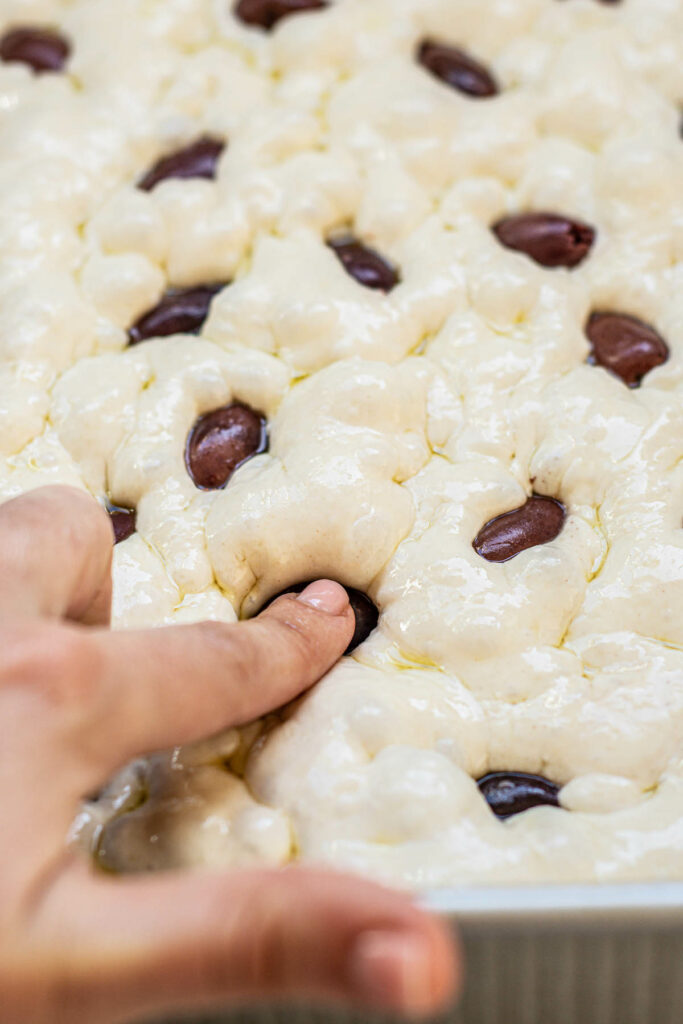
Press sliced olives deep into the dough.

Press the rosemary leaves. Sprinkle the dough with flaky salt
Baking
Bake the focaccia for around 25-30 minutes until puffed and deep golden brown and the bread pulls away from the edges of the baking dish. If the top start browning too much, loosely cover the bread with aluminum foil.
Remove it from the oven and let it sit for 3-4 minutes. Carefully remove it from the pan then let it cool further on a wire cooling rack before serving.

Other focaccia topping ideas
- Sun-dried tomatoes
- Caramelized onion and goat cheese
- Basil pesto or sun-dried tomato pesto
- Thinly sliced potatoes
- Fresh tomatoes and red onion
Serving and storing
Fresh sourdough focaccia bread can be eaten as is. The flavours of salt, good quality olive oil and herbs make it delicious all on its own. Focaccia bread can be used to make sandwiches, or the dough can be spread out thinner and used as the base for a pizza.
Focaccia bread that is older can be rewarmed in the oven. It makes a great bread to dip into soups or to mop up pasta sauces.

More bread recipes

Easy Sourdough Focaccia Recipe
This simple sourdough focaccia recipe has a soft interior and a deliciously crispy exterior.
Ingredients
Sourdough starter
- 25g (1 3/4 Tablespoons) sourdough starter
- 50g (7 Tablespoons) all-purpose flour
- 50g (3 1/2 Tablespoons) water
Dough
- 500g (4 cups*) all-purpose or bread flour
- 430g (1 3/4 cups + 1/2 Tablespoon) water
- All the sourdough starter
- 8g (1 1/2) teaspoons salt
Toppings
- Kalamata olives
- Fresh rosemary
- Flaky salt
Instructions
- In the morning or the evening before**, feed your sourdough starter. Let it rise until doubled in size.
- In a large bowl, add water, sourdough starter, flour and salt. Use a rubber spatula or wooden spoon to combine it all together into a wet and shaggy dough.
- Over a period of 2 hours, perform 4 sets of stretch and folds, one every 30 minutes.
- A stretch and fold method is when one side of the dough is stretched up and pulled over itself. The bowl is then turned and this move is repeated on the following side. Continue stretching and folding and turning the bowl until all sides have been folded. That is one set of stretch and folds. The first set of stretch and folds will be very shaggy and the dough will rip easily. As the folds are carried out over the next while, the gluten structure is created and the dough gains strength.
- Each time the dough sits, cover the bowl with a damp kitchen towel to stop the top of the dough from drying out.
Bulk fermenting
- After the final stretch and fold the dough rise at room temperature around for 2-4 hours. There should be signs of bulk fermentation happening in the dough with many bubbles appearing.
- This depends on the temperature of your kitchen. A cooler kitchen will the dough to sit a bit longer, or you can create a warm spot by placing a mug of boiled water in a turned-off oven.
- Transfer the dough to an airtight container or cover the bowl with plastic wrap.
- Place it in the fridge overnight, or for up to 36 hours for an extra-long ferment.
Shaping
- Drizzle the bottom of the baking tray with a generous amount of olive oil. You can line the pan with parchment paper as well if you think your pan might stick.
- Transfer the cold dough to the oiled pan.
- Leave it to sit and rest for 10 minutes, then oil your fingers and press your fingertips into the dough to spread the dough out into the pan. If the dough resists stretching out, give it a rest and try again in a few minutes.
- Let the focaccia dough rise in a warm place until it is jiggly and puffy. This can take anywhere between 3-5 hours depending on the room temperature.
- Cover the dough at this point or, brush it with extra virgin olive oil to stop the top of the dough from drying out.
Dimpling and topping
- Preheat the oven to 450°F/230°C.
- Drizzle a little olive oil over the surface of the dough, then use oiled fingers to create deep dimples on the top of the focaccia dough, pushing all the way down. Do this all over the entire surface.
- Press sliced olives deep into the dough. Press the rosemary leaves. Sprinkle the dough with flaky salt.
- Bake the focaccia for around 25-30 minutes until puffed and deep golden brown and the bread pulls away from the edges of the baking dish. If the top start browning too much, loosely cover the bread with aluminum foil.
- Remove it from the oven and let it sit for 3-4 minutes. Carefully remove it from the pan then let it cool further on a wire cooling rack before serving.
Notes
*The cup sizes given are for US cups. Note that these are smaller than metric cup sizes. For best results, use grams.
**If you are feeding your starter overnight, add a little less starter and more flour and water to slow the rise so it doesn't collapse overnight. Eg, 20g starter : 60g flour : 60g water
Recommended Products
As an Amazon Associate and member of other affiliate programs, I earn from qualifying purchases.
Nutrition Information:
Yield: 10 Serving Size: 1Amount Per Serving: Calories: 207Total Fat: 1gSaturated Fat: 0gTrans Fat: 0gUnsaturated Fat: 0gCholesterol: 0mgSodium: 311mgCarbohydrates: 44gFiber: 2gSugar: 0gProtein: 6g
This is an informational estimate only. I am not a certified Dietitian or Nutritionist

